This Kimchi Jjigae is comforting and nourishing, and super easy to make! Make this Kimchi Stew at home with this easy recipe with step-by-step photos.
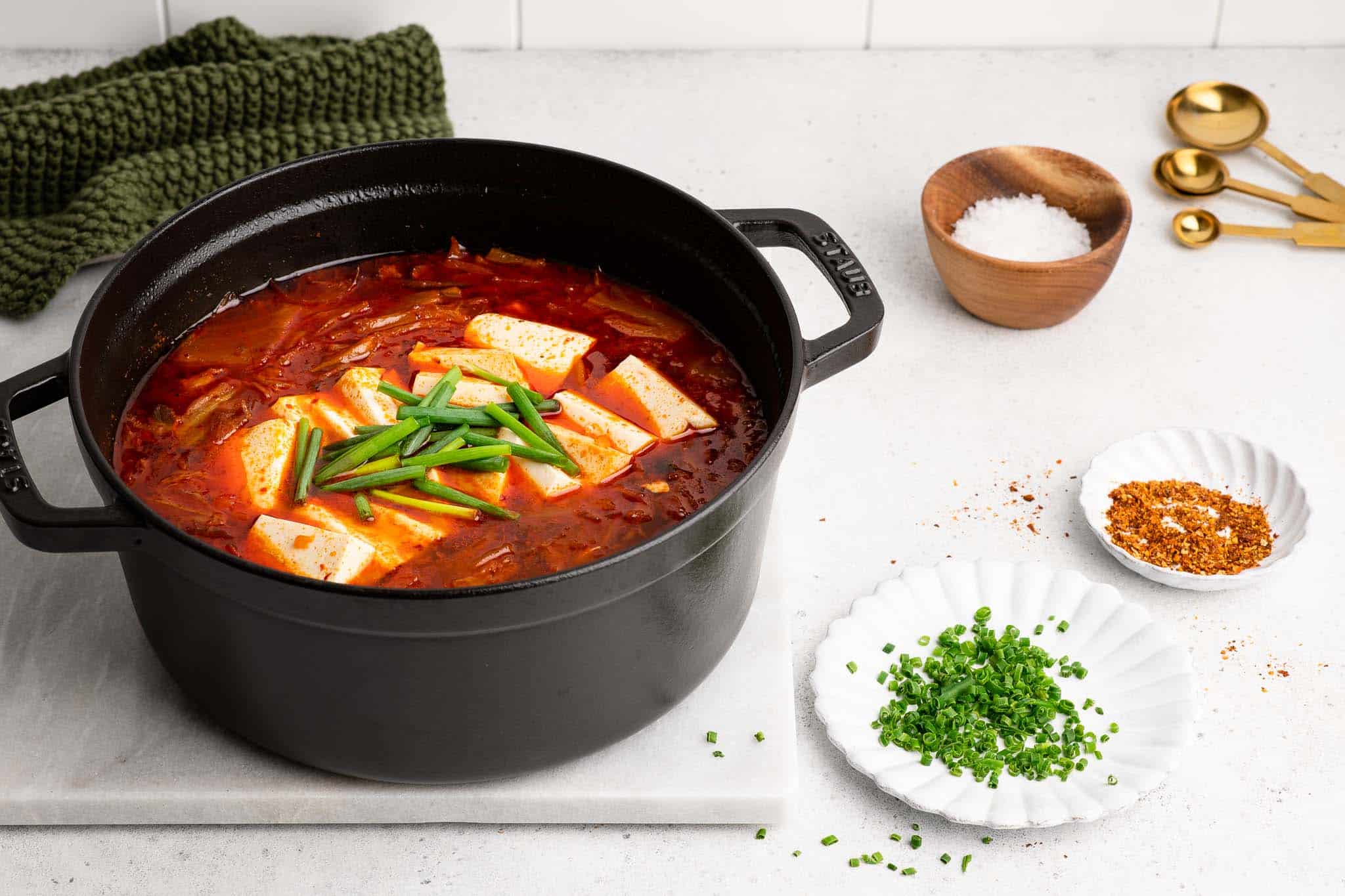
Kimchi Jjigae
If there is a dish that defines my early days as a fresh-faced lawyer in Brisbane, this Kimchi Jjigae would be it. After long days of drafting affidavits, court hearings, mediations and other thrilling adventures, I always looked forward to grabbing dinner in town with my girlfriends.
One of our favourite haunts was a Korean restaurant near my office, and if we weren’t ordering a Budae Jjigae to share, I always relished a serve of this Kimchi Jjigae. To me, it was pure comfort food in a bowl.
What is Kimchi Jjigae?
Kimchi Jjigae is also called Kimchi Stew. It is a soup made with kimchi and tofu, and served simply with steamed rice.
This is the sort of soup that you want to eat on a blisteringly cold day or if you are feeling a bit under the weather, as it is warming, comforting and nourishing. It can also be as spicy as you need it to be.
It happens to be a very simple and humble dish, but it benefits from all of the complex flavours in kimchi to give it a lot of punch and addictive taste.
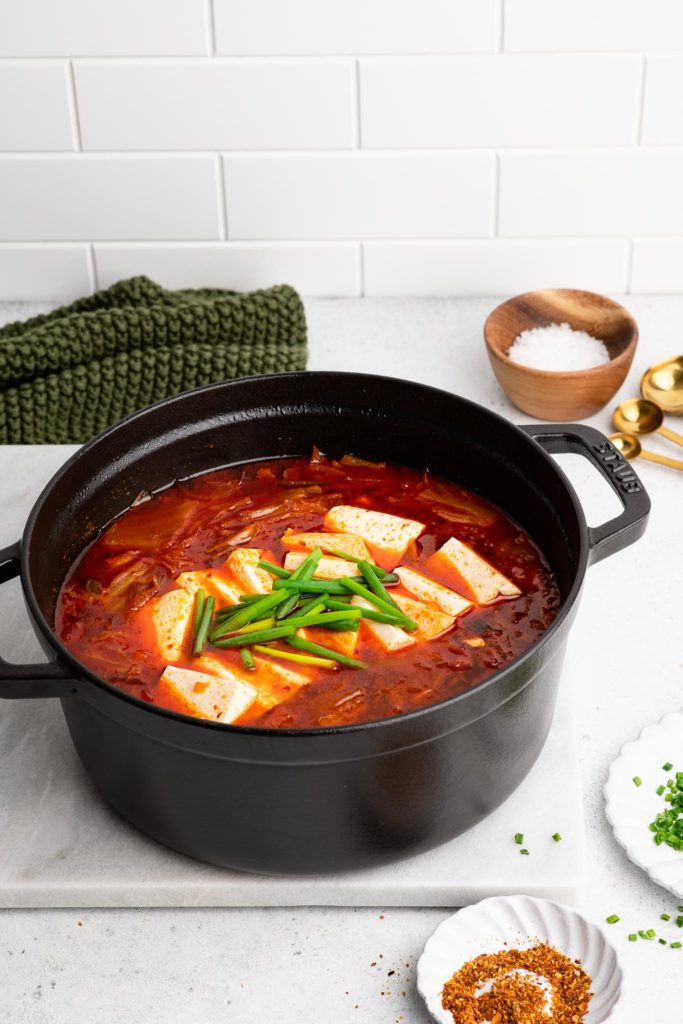
Kimchi Stew Recipe
For years, I didn’t dare to try and make Kimchi Jjigae at home because I thought it was too complicated, that Korean cuisine was too unfamiliar.
But I had a tub of kimchi languishing in my fridge one day, and rather than make another Kimchi Fried Rice, I thought I would give this soup a try. I figured it would be just like making any other soup, except with kimchi as the star ingredient. And I am so glad I tried because my version of Kimchi Jjigae brings back all of the taste memories of the same dish back in Brisbane almost 20 years ago, and it might be even better!
Kimchi Jjigae Recipe
My Kimchi Jjigae recipe uses pork belly as the main protein, mostly because my favourite versions of this soup have always had pork belly, but you could also substitute for chicken or even leave the meat out entirely for a vegetarian dish. However, because I render the pork belly at the start of the recipe, all of the lovely fat from the pork belly gives a nice richness and depth of flavour to the soup, something which I think is crucial to this recipe.
Kimchi Jjigae always has tofu (my favourite part of the dish), and I like to use silken tofu, mostly because I love the soft texture of this type of tofu. However, you can also use a firmer tofu in this recipe, if you prefer.
What Type of Kimchi to Use
Obviously the star of this dish is the kimchi, and I think the type and brand of kimchi that you use will affect the overall flavour of this soup. So make sure you use a kimchi which you like, i.e. make sure that it tastes good, that it has the right level of heat, and that it has the right ratio of cabbage to other ingredients (some kimchi are heavy on other ingredients like radishes and carrots).
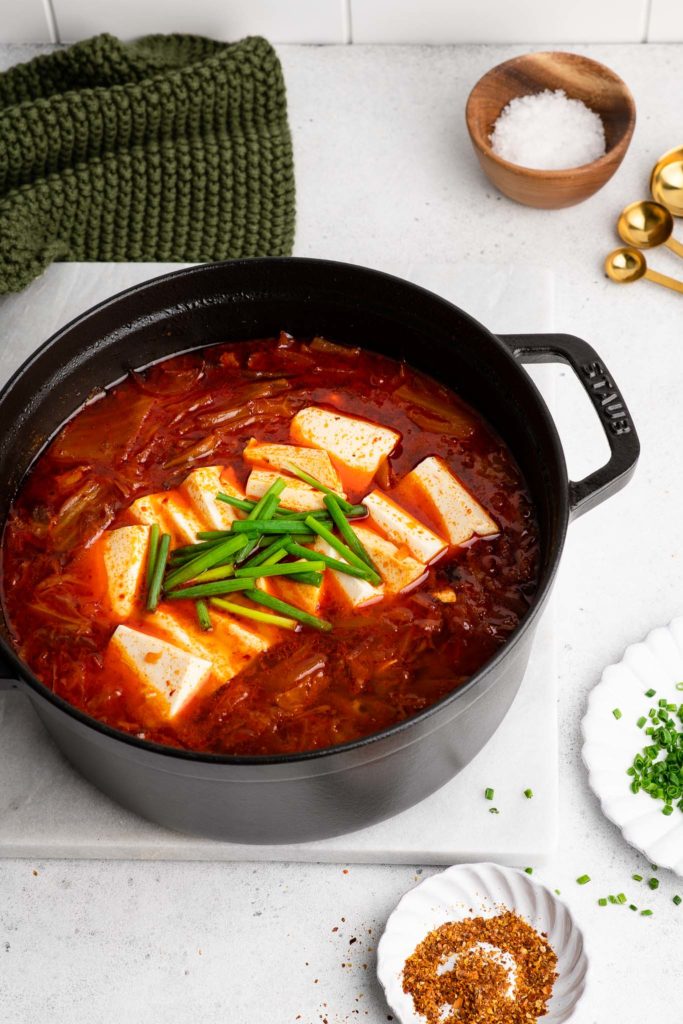
Different Types of Chilli Flakes
Chilli flakes have different levels of heat. It’s best to start off with less and to taste as you go, adding more chilli flakes to taste.
Italian-style chilli flakes (the most common sort found in supermarkets) generally have a mild heat.
Thai or Vietnamese-style chilli flakes are usually made from birds eye chillies, which are very spicy. I only stock this type of chilli flake in my pantry as I like the level of heat it gives.
What is Gochugaru?
Gochugaru is the name of Korean-style chilli flakes which is used in many Korean recipes, including kimchi and soups. It comes in a fine or coarse powder, and it gives the signature red colour to many Korean dishes. The level of heat can vary depending on the brand.
If you can’t find Gochugaru, regular chilli flakes are a very good substitute, although you might have to use a bit more depending on the level of spice you want. In fact, if you don’t cook Korean cuisine very often, I would recommend that you stick to regular chilli flakes as I don’t think Gochugaru is a crucial ingredient here.
What is Gochujang?
Speaking of crucial ingredients, you will need to source Gochujang in order to make this Kimchi Stew.
Gochujang is a Korean spice paste which adds savouriness and colour to a dish, but it is not necessarily spicy. So if you want to increase the level of spice in a Korean dish, don’t add more Gochujang because this will just add more salty flavours. Instead, to make a Korean dish more spicy, add more chilli flakes or Gochugaru to taste.
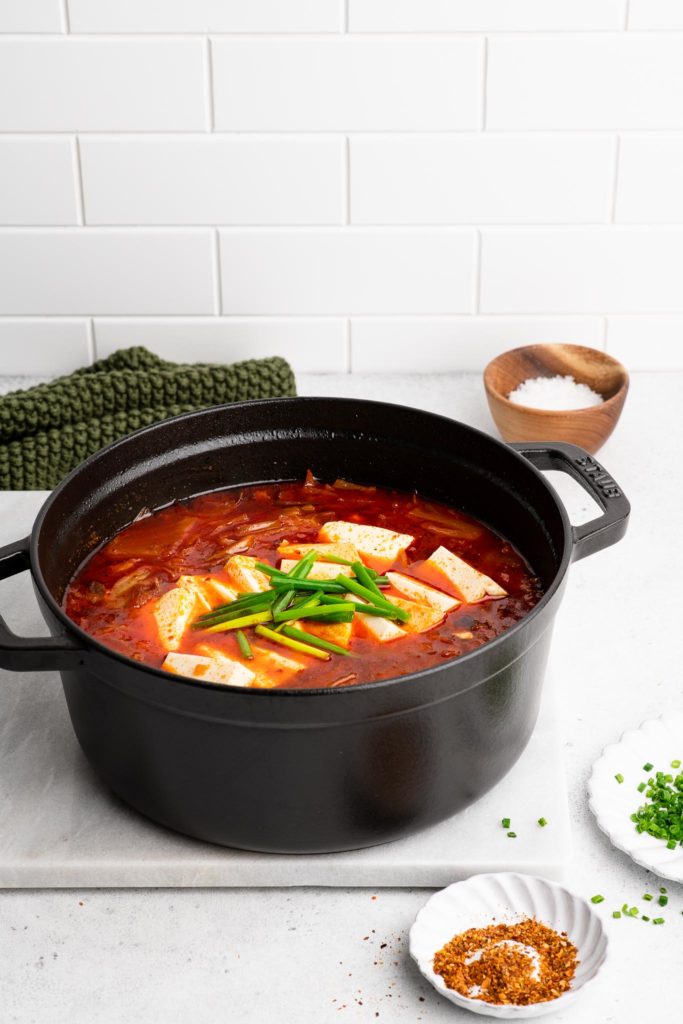
How to Make Kimchi Jjigae
Step 1
Heat some oil in a large saucepan (I like to use a cast-iron pot for this dish) and add the pork belly (cook in batches if necessary). Season the pork generously with sea salt and freshly ground black pepper. Cook the pork belly slices until they are nicely golden.
If the pork belly has produced a lot of fat, remove some fat from the pan, if necessary. Otherwise, you will need a few tablespoons of oil or fat in the pan for the rest of the recipe.
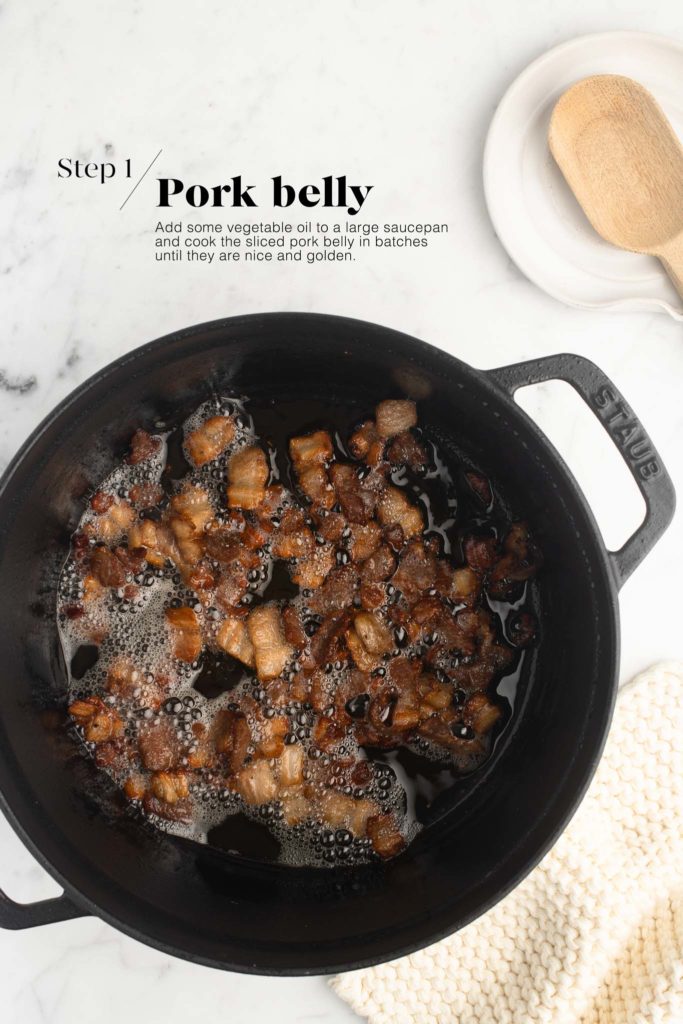
Step 2
Add the onions and cook for a few minutes until they have softened.
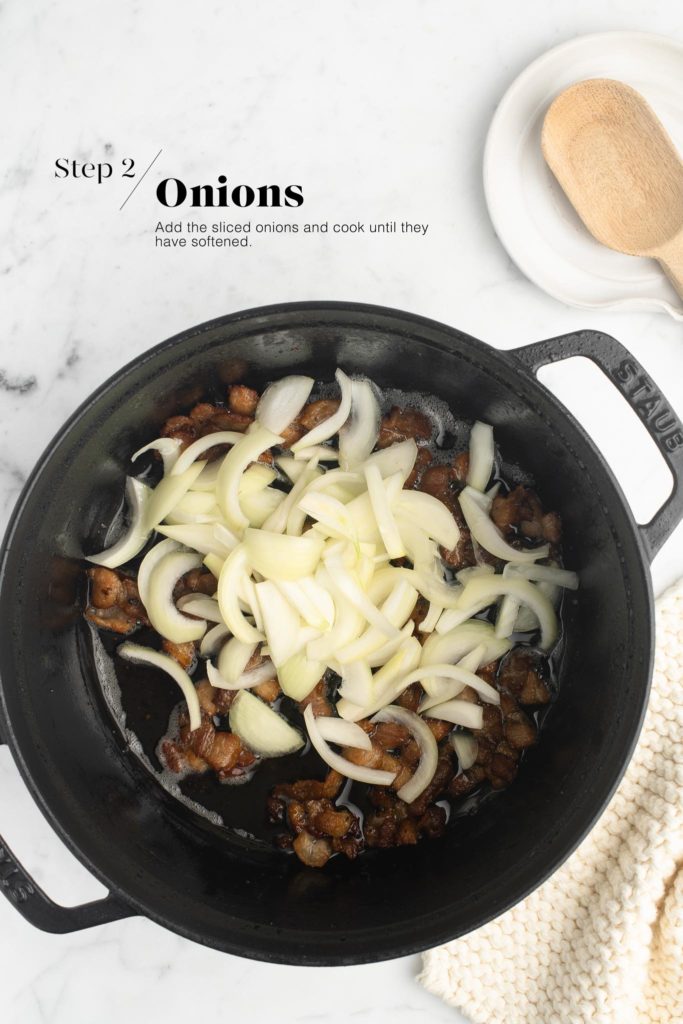
Step 3
Add the kimchi, together with any juices from the kimchi packet or container. Cook for a few minutes until the kimchi is warmed through.
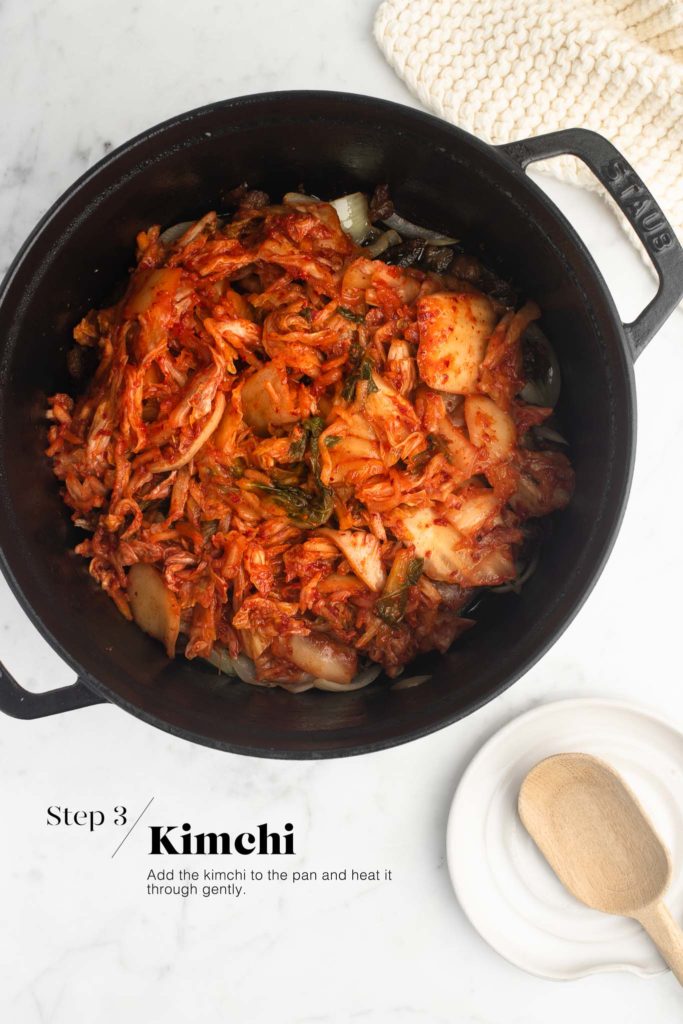
Step 4
Add the chicken stock and bring everything to a gentle simmer.
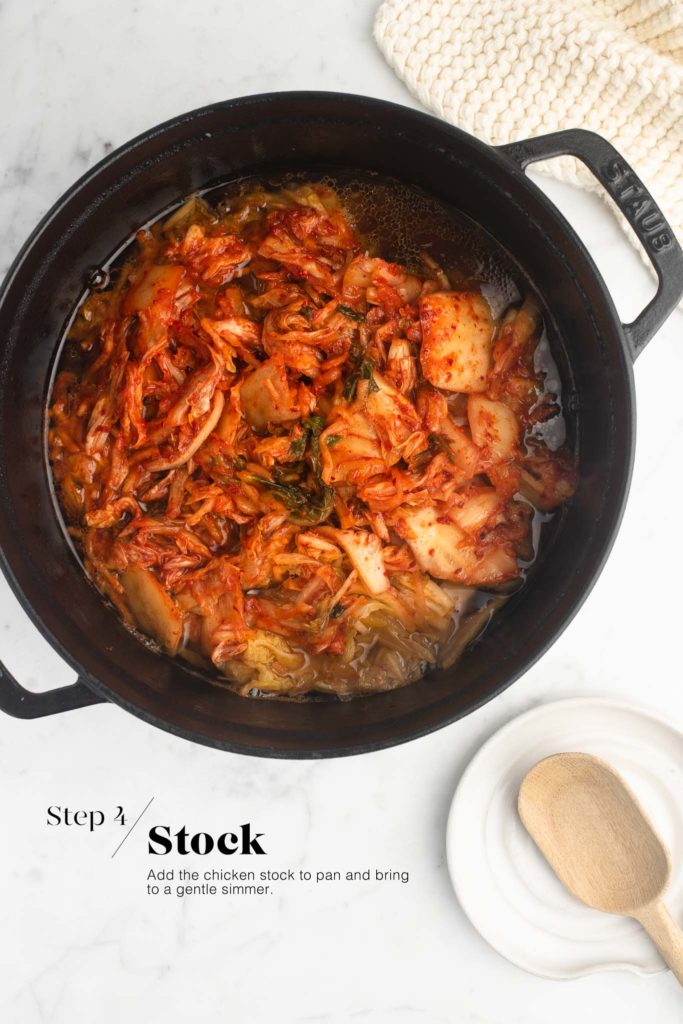
Step 5
Add the Gochujang, chilli flakes (or Gochugaru), salt and sugar. Simmer gently for 15-20 minutes. Taste for seasoning.
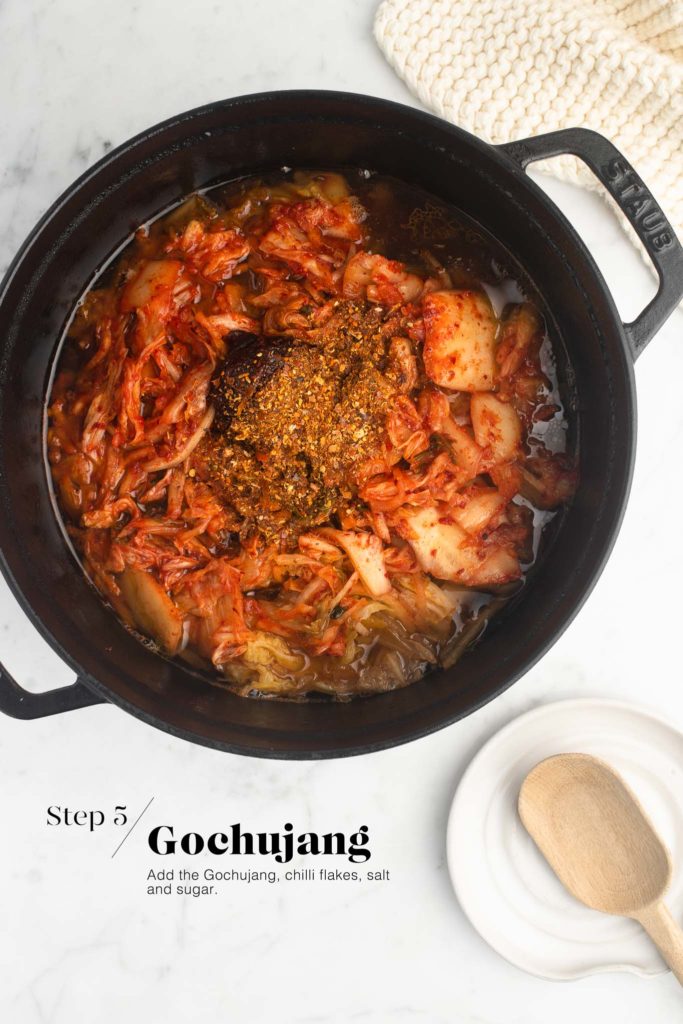
Step 6
Add the sliced silken tofu and cook for a few minutes until the tofu has warmed through. Be careful not to break the tofu.
Garnish with spring onions (scallions) and serve with steamed Jasmine rice.
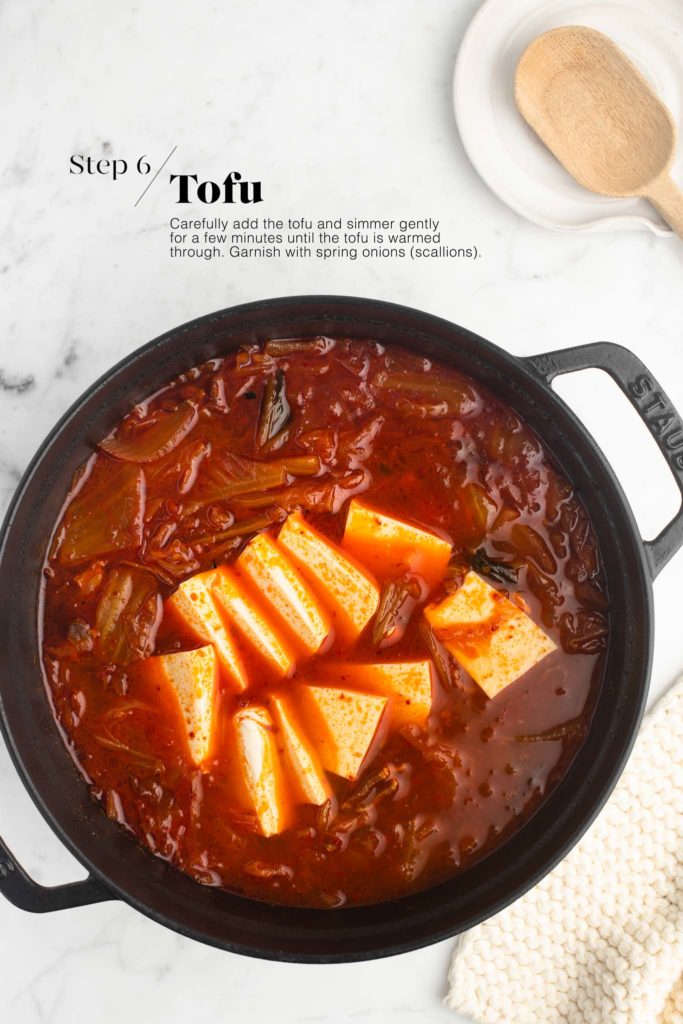
Make Ahead Tips
Kimchi Jjigae freezes and defrosts really well. I highly recommend making a large batch and freezing them in ziplock freezer bags containing 1-2 portions.
When making Kimchi Jjigae ahead of time, leave out the tofu as tofu generally does not freeze very well. Instead, add the tofu once you have reheated the soup.
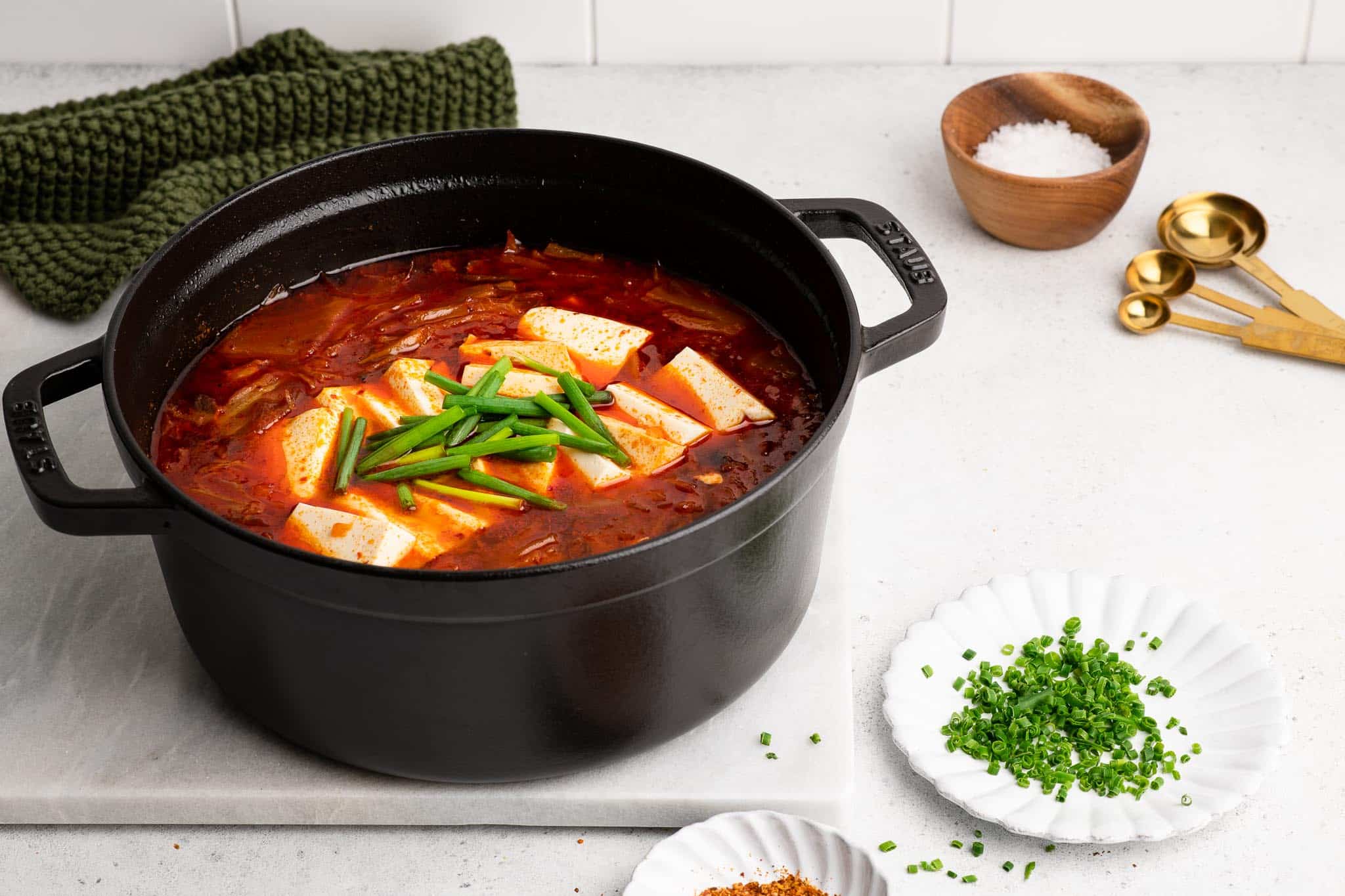
More Korean Recipes
If you are looking for more Korean recipes, you might also like:
PrintKimchi Jjigae (Kimchi Stew)

- Prep Time: 15 mins
- Cook Time: 30 mins
- Total Time: 45 minutes
- Yield: Serves 6 to 8
- Category: Soup
- Method: Stove
- Cuisine: Korean
This Kimchi Jjigae is comforting and nourishing, and super easy to make! Make this Kimchi Stew at home with this easy recipe with step-by-step photos.
Ingredients
For the Kimchi Jjigae
- 1–2 tablespoons vegetable oil
- 400 g (14 oz) pork belly, without rind, thinly sliced
- coarse sea salt
- freshly ground black pepper
- 2 small onions, sliced
- 600 g (21 oz) kimchi (see Kitchen Notes)
- 1.5 litres (6 cups) chicken stock
- 1 tablespoon Gochujang
- 1–2 teaspoons chilli flakes or Gochugaru (see Kitchen Notes)
- 1 teaspoon fine sea salt
- 1 teaspoon sugar
- fish sauce, optional (see recipe instructions)
- 500 g (1 lb) silken tofu, thickly sliced
To serve
- spring onions (scallions), sliced
- Steamed Jasmine Rice
Instructions
- Heat the oil in a large saucepan over medium-high heat.
- Add the pork belly (in batches) and season generously with sea salt and freshly ground black pepper.
- Cook the pork belly (in batches) until it has browned nicely.
- If the pork belly has produced a lot of fat, remove some fat from the pan, if necessary. Otherwise, you will need a few tablespoons of fat/oil in the pan for the rest of the recipe.
- Add the onions and cook until softened.
- Add the kimchi, together with all of the juices from the kimchi packet or container. Cook for a few minutes until warmed through.
- Add the stock and bring everything to a gentle simmer.
- Add the Gochujang, chilli flakes, salt and sugar.
- Simmer gently for 15 to 20 minutes.
- Taste for seasoning. If the soup needs more salt, consider adding a dash of fish sauce.
- Add the sliced tofu and cook for a few minutes until the tofu has warmed through. Take care not to break the tofu.
- Garnish with spring onions (scallions).
- Serve with steamed rice.
Kitchen Notes
 TYPES OF KIMCHI
TYPES OF KIMCHI
Some brands of kimchi contain fish sauce which will add extra flavour/umami to a soup like Kimchi Jjigae. So if you are using a kimchi which does not contain fish sauce, consider adding a dash of fish sauce to the soup if it needs a bit more salt.
 CHILLI FLAKES VS GOCHUGARU
CHILLI FLAKES VS GOCHUGARU
* Chilli flakes have different levels of heat. Add as much or as little as you like to this dish. It’s best to start off with less and to taste as you go, adding more chilli flakes to taste.
* Italian-style chilli flakes (the most common sort found in supermarkets) are generally not as spicy as Thai or Vietnamese-style chilli flakes.
* Thai or Vietnamese-style chilli flakes are usually made from birds eye chillies, which are very spicy. I only stock this type of chilli flake in my pantry as I like the level of heat it gives.
* Gochugaru is the name of Korean-style chilli flakes which is used in many Korean recipes, including kimchi and soups. It comes in a fine or coarse powder, and it gives the signature red colour to many Korean dishes. The level of heat can vary depending on the brand.
 FREEZER TIPS
FREEZER TIPS
Kimchi Jjigae freezes and reheats very well. I recommend freezing the soup in ziplock-freezer bags with 1-2 portions. However, omit the tofu when freezing. Instead, add the tofu when you are reheating the soup.
 CONVERSIONS
CONVERSIONS
To convert from cups to grams, and vice-versa, please see this handy Conversion Chart for Basic Ingredients.
 Print
Print Pin Recipe
Pin Recipe Rate
Rate
Wow this was so delicious! I made it exactly as per your recipe and it tasted amazing. Perfect for this cold weather we are now having in Melbourne 🙂
This is the dish I always order when we go to a Korean restaurant and I never thought I would try to make it at home either. But omg it tasted so delicious and even better than at the restaurant!! Your recipe is just amazing.
This was so yummy! I’m going to make this all the time!
I had no idea this soup would be so easy to make at home. This was insanely delicious!
Thank you for this recipe! It was soooo delicious!